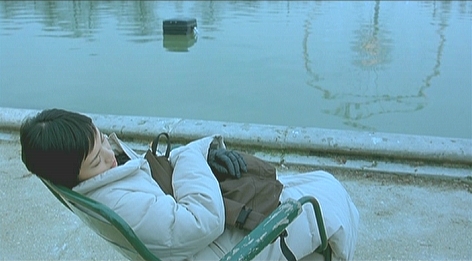
From the cramped quotidian living spaces of Taipei to chilly Parisian streets, What Time is it There displays the alienation of two souls with graceful sensitivity. Like the rest of Tsai Ming-Liang's cinema, it is contemplative and lingers on the loneliness of its inhabitants, but it also has a humorous poignancy that is rare in his films. Where Goodbye, Dragon Inn shifts into hollowness, What Time is it There delves into Charlie Chaplin on depressants. Most of the comedic sequences are very dry, but there are a few that exhibit methodical physical comedy.
The overarching sentiment is not a humorous one however; just gaze into the powerfully stagnate expression on Lee Kang-Sheng's face and you'll get the idea. He plays the characteristic loner in Ming-Liang's work. Here he is a twentysomething living with his mother after his father died, and working on the streets of Taipei selling watches. When a young woman confronts him one day and shows an interest in one of his watches, the two forge a mystifying connection. She informs him that she's taking a trip to Paris, so he sells her the watch before she leaves and proceeds to set as many clocks as he can find to Paris time. His actions seem trivial, but they also appear to be rooted in a kind of supernatural longing for the girl. Presumably to feel connected with her, he even watches and rewatches the classic French film The 400 Blows. Simultaneously, the mother whom he's distancing himself from prays incessantly in hopes of regaining the spirit of her lost husband, whether in his original form or in that of a cockroach in the living room fish tank. (The explanation for this odd sentence can be found in one of the hilarious scenes of the film).
The lives of these three quite Bressonian characters are observed silently. Deviations from the apparent "plot" are aplenty, but it's the cumulative urban remoteness that is important. Feelings of hopelessness are only eradicated partly by the meaningless erotic behaviors that the three engage in late in the film. Ming-Liang's film is substantially alienating because of the spare camerawork. There is always a feeling of existential detachment in the wide angled shots that reveal several important compositional elements before the faces. Not a single camera movement is existent either; instead the audience is left to imprint the gorgeous visuals that are forever static on the screen. Red, green, and black swirl at different depths in each shot, creating mesmerizing mosaics as beautiful as any shot in Goodbye, Dragon Inn. After the enigmatic ending of the masterful What Time is it There, I was left with a brain stamp of a Ferris wheel and loads of thoughts.

1 comment:
hey carson.
i just noticed you link to my site and I've read pretty much your whole blog and can i just say thanks so much! i've been stuck far too much in the world of music and have neglected watching films for a long time. you've really kick started me into checking out more films regularly. and this looks like a perfect way to start
Post a Comment